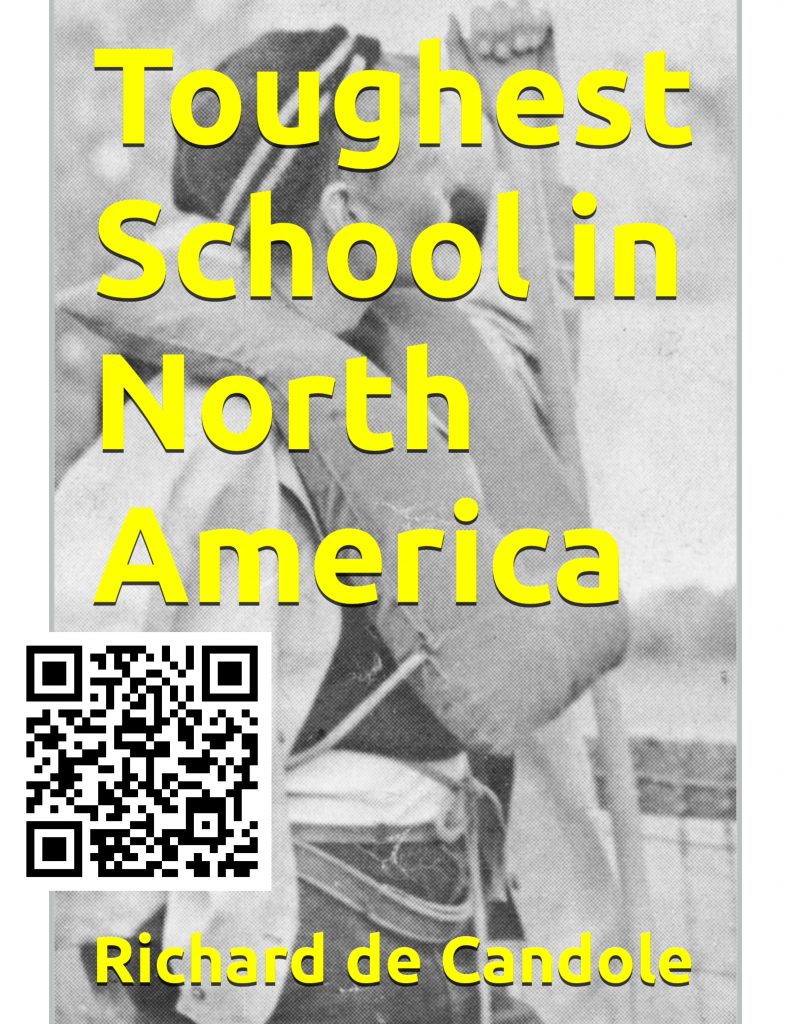
Davies and Byfield had just passed the incinerator and were on their way in when they spotted Mr. Thompson coming out the back door.
He appeared to be heading for the barn until he suddenly stopped where the two paths met. They were pretty sure they knew why but they weren’t going to do anything to attract attention. They resumed their conversation and kept walking. As they approached the meeting point they realized some sort of an encounter was about to unfold. Mr. Thompson was still standing there.
On their way by they mumbled a salutory “Sir,” hoping that would be the extent of the contact. He nodded in return but seemed preoccupied with sniffing the air.
“Davies, Byfield,” he called out.
“Vous avez la connaisance du tabac, n’est pas? I think you had both better report to my room so we can investigate further.”
Michael Davies had become a student a year earlier when his father Ted joined as a master. Although he had only taken first-year French he knew enough to figure out what “tabac” meant. Byfield, in his third year of French, realized from the other words their worst fears were about to unfold. It may not have been perfect French – even the teachers were learning the course as they taught it – but there was no point pleading ignorance.
Mr. Thompson would have been more than happy to provide a translation. Five minutes later they both emerged from his room having received the customary 10 of the best for smoking. And Davies was a couple of words wiser about Canada’s other official language.
That was during my Grade 10 year and most of the class was at Davies’s level. As a class, we had not shown what one would describe as a natural flair for languages.
Only a few of us were considered skilled enough in Latin to begin a second language in Grade 8. By Grade 9 a majority of the class were still at the first-year level in French. At no time was this lack of aptitude better demonstrated than during French dining room, an experience we shared in the library at lunch with Grade 11 and 12 students.
The sessions were of course intended to encourage us to actually speak the language. The prospect of going hungry provided enough incentive for everyone to at least try.
In the public system, after three years of French, it was regarded a success if you were able to order pizza or knew how to give directions to Notre Dame in Paris. Students were getting passing grades because they had learned enough vocabulary and grammar for the exam but for the most part, they couldn’t speak the language.
The school felt much of the fault lay with the textbooks. Students were being turned off speaking French because the vocabulary wasn’t relevant to Canada.
The school decided to develop a course that would focus not on Paris but on early French Canada, the lifestyle of the voyageurs in particular.
The shift was reflected in the very first set of sentences students were asked to translate.
‘Here is the canoe. The canoe is on the lake. The river flows into the lake. The canoe is shooting the rapids.’
And since there was almost as much fighting in the life of the early fur trader as there was paddling the language of battle also figured prominently in the first year exercises. To ensure correct pronunciation the school asked French radio announcer Louis Lariviere to tape record translations of the exercises.
Another difference was its sheer volume. A first-year student was required to complete 400-word exercises plus redo earlier mistakes several times a week. It worked out to six thousand words of translation per term. Most of the next day’s class would be devoted to marking. It was time-consuming but it served to reinforce the vocabulary and grammar being learned. While there was no textbook, Cassell’s French English dictionary was absolutely indispensable. At the back were tables showing how to conjugate all the regular and irregular verbs.
The walls of most classrooms including the dining room were covered with blackboards. The marking process was simple. At the beginning of class, Mr. Byfield would divide up the sentences for translation among the members of the class. The assigned sentences would be written on the blackboards with some students standing on benches while others worked underneath on their knees. Once they were up notebooks would be exchanged and, with Mr. Byfield’s guidance, we would mark the work on the board and in the notebooks. It was a brilliant system for any teacher who has better things to do than mark schoolwork. Only the marking of corrections would ever get personal attention from either Mr. Byfield or his wife Virginia.
By my Grade 10 year there were three bonafide graduates to serve as an inspiration. Tom Carson, Jim McKay, and Rob Wallace had completed the three-year program and then spent the summer in Quebec polishing their conversational skills.
Had it not been for them and a few other keen students in Grade 11, Mr. Byfield would have found himself sitting through some long, conversationless meals.
I always get a kick out of the fact the cover of the annual report, St. John’s ’66, depicts hard-hatted students puzzling over a document one presumes to be construction-related but is in fact the schedule for the French dining room. There was never much appetite for attending those meals.
Once the flurry of “passez-moi le this and la that” had subsided conversation tended to be an exchange of French fragments joined by long periods of restless silence.
Discussion about the possibility of there being seconds of the meat dish was a popular topic as was the dessert for that day. When things really began to drag Mr. Byfield might ask specific questions in an effort to draw individuals into discussion.
It was a different story when neither Mr. Byfield nor other masters were present. French words continued to be spoken but seldom grammatically and often using Frenchified English words. One’s lack of proficiency became much more amusing than when a master was present.
“Passez la poisson, Cooper,” Baptiste would say and in return would come “Cherchez it yourself.” To which someone would mockingly demand “Parlez Francaise”
And that would open the door to a stream of abuse using all the swear words we had been taught by the three graduates from their time in Quebec – “fermes ta gueule” being the most printable.
Our French might not have improved that much but I think we ate better. For some reason, our numbers used to fluctuate between eight and 16 people (one or two tables). When the server went down for a refill the cook wasn’t able to do an eyeball check. That meant we usually got a large refill. On cinnamon bun day that was a substantial benefit.
Interest in oral French jumped significantly when it was announced one spring a television was going to be set up in the French lab so we could, “for instructional purposes” watch the Stanley Cup playoffs.
We were already listening to French radio broadcasts and translating of some of the play-by-play. Watching the games on TV was intended to assist the process.
By some miracle, it was considered an acceptable alternative to studying in the dining room. While we were supposed to be in third-year French there was little stopping us from sitting at one of the tape recorders with eyes glued to the TV set. It was the only time we were ever allowed to watch TV.
Richard de Candole has been working in British Columbia and Alberta as a reporter and editor for over 40 years. Toughest School in North America is about his five years as a student at St. John’s Cathedral Boys’ School in Selkirk, Manitoba from 1962 to 1968. Richard lives with his wife Wendy in Qualicum Beach, British Columbia.
bedard.com is serializing Toughest School in North America for your reading pleasure. I hope you enjoy it as much as I do. If you’d like to preorder a copy of the book, leave a reply below. All replies are moderated.


